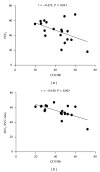Increased numbers of NK cells, NKT-like cells, and NK inhibitory receptors in peripheral blood of patients with chronic obstructive pulmonary disease
- PMID: 24069043
- PMCID: PMC3773417
- DOI: 10.1155/2013/721782
Increased numbers of NK cells, NKT-like cells, and NK inhibitory receptors in peripheral blood of patients with chronic obstructive pulmonary disease
Abstract
T cells and B cells participate in the pathogenesis of COPD. Currently, NK cells and NKT cells have gained increasing attention. In the present study, 19 COPD patients and 12 healthy nonsmokers (HNS) were recruited, and their pulmonary function was assessed. The frequencies of CD3(+) T, CD4(+) T, CD8(+) T, B, NK, and NKT-like cells were determined using flow cytometry. The frequencies of spontaneous and inducible IFN- γ (+) or CD107a(+) NK and NKT-like cells as well as activating or inhibitory receptors were also detected. The potential association of lymphocyte subsets with disease severity was further analyzed. Significantly decreased numbers of CD3(+) and CD4(+) T cells, and the CD4(+)/CD8(+) ratio, but increased numbers of CD3(-)CD56(+) NK and CD3(+)CD56(+) NKT-like cells were observed in COPD patients compared to HNS. The frequencies of inducible IFN- γ -secreting NK and NKT-like cells were less in COPD patients. The frequencies of CD158a and CD158b on NK cells and CD158b on NKT-like cells were greater. The frequency of CD158b(+) NK cells was negatively correlated with FEV1% prediction and FEV1/FVC. Our data indicate that COPD patients have immune dysfunction, and higher frequencies of inhibitory NK cells and NKT-like cells may participate in the pathogenesis of COPD.
Figures




References
-
- Lopez AD, Mathers CD, Ezzati M, Jamison DT, Murray CJ. Global and regional burden of disease and risk factors, 2001: systematic analysis of population health data. The Lancet. 2006;367(9524):1747–1757. - PubMed
-
- Rabe KF, Hurd S, Anzueto A, et al. Global strategy for the diagnosis, management, and prevention of chronic obstructive pulmonary disease: GOLD executive summary. The American Journal of Respiratory and Critical Care Medicine. 2007;176(6):532–555. - PubMed
-
- Miller LG, Goldstein G, Murphy M, Ginns LC. Reversible alterations in immunoregulatory T cells in smoking. Analysis by monoclonal antibodies and flow cytometry. Chest. 1982;82(5):526–529. - PubMed
-
- Ginns LC, Goldenheim PD, Miller LG, et al. T-lymphocyte subsets in smoking and lung cancer. Analysis by monoclonal antibodies and flow cytometry. The American Review of Respiratory Disease. 1982;126(2):265–269. - PubMed
MeSH terms
Substances
LinkOut - more resources
Full Text Sources
Other Literature Sources
Medical
Research Materials

